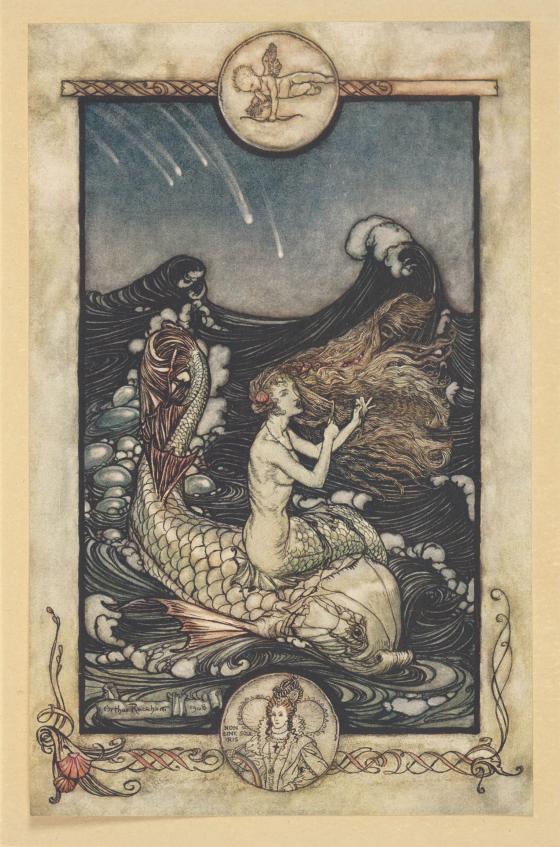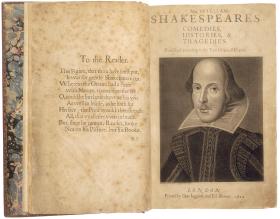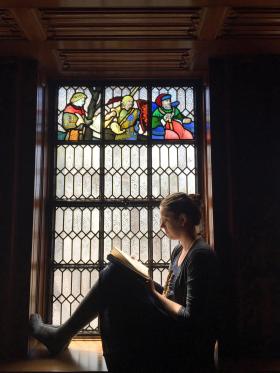I should begin by putting all my cards on the table. I’m fascinated by Shakespeare and his books, including the First Folio. In the immediate pre-Covid years, I took my family on an international library tour. Perhaps what made for an even more unexpected family holiday was that it was also a First Folio tour.
We called first on the Weston Library in Oxford and saw, up close, the famous Bodleian copy — unceremoniously offloaded by the Bodleian Library in the seventeenth century, then eagerly repurchased in 1905.
We also visited the British Library’s substantial Shakespeare holdings and the even larger collection of First Folios at Meisei University in Tokyo. Our tour included the largest Shakespeare collection of them all, the Folger Shakespeare Library in Washington DC, home to a remarkable 82 First Folios. (There are 233 known surviving copies, although some are damaged or incomplete, and others have pages from later editions added.)
Some people ask if the First Folio should even be attributed to the Bard. My position on this controversial yet tedious question, ‘Who wrote Shakespeare?’, is entirely orthodox. All the ‘secret author’ theories — which nominate Francis Bacon, Henry Neville, Edward de Vere and any number of others as the ‘real Shakespeare’ — are emphatically and demonstrably baloney.
All the same, my attitude and orientation towards Shakespeare diverges from some writers in this crowded field. I’ve made a career out of irreverent — and sometimes spicy — writing about respectable and even nerdy subjects. Perhaps more than any other subject in my chosen categories of libraries, publishing, finance and legal history, Shakespeare invites — even demands — irreverence and spice.
Moreover, as an Australian writing in Australia about Shakespeare today, I feel I can write from a sceptical distance. Four centuries plus 17,000 kilometres adds up to a lot of objectivity.
From this viewpoint, far away from Stratfordupon-Avon, three nested myths — assumptions that underpin Shakespeare’s global cultural status — stand out starkly. The first is the myth of Shakespearean genius. The second is the myth of solo Shakespearean genius and the final myth is of Shakespeare as a solo and an English genius. Let’s look at each in turn.
The idea of Shakespeare as an authorial genius is ripe for rebuttal. This is because his method consisted mostly of adapting texts that already existed. In Shakespeare’s time, people could read about the doomed characters of Hamlet, King Lear, Romeo and Juliet or Antony and Cleopatra without going near anything he wrote.
Hard as it may be for us to comprehend, during his lifetime Shakespeare was not a major literary figure. The foremost poets and playwrights of his time disparaged his writings as clumsy hackwork. And to the extent that he had a reputation as a poet, he was known as a purveyor of libidinous verse — ideal as an aid for what Michael Schoenfeldt in the Cambridge Introduction to Shakespeare’s Poetry termed ‘solitary pleasure’.
Shakespeare’s posthumous reputation depended on arbitrary twists and turns that were not preordained by his genius. In the eighteenth and early nineteenth centuries, Romantic poets and critics such as Coleridge, Hazlitt and Keats adopted him, as did theatre entrepreneur David Garrick, who pumped him up spectacularly with the 1769 Shakespeare Jubilee.
But Garrick and the Romantics could easily have chosen to boost another early-modern author — perhaps one of Shakespeare’s contemporaries Ben Jonson, Christopher Marlowe, Robert Greene, Francis Beaumont or John Fletcher.
It is worth recalling that some of the marvels of ‘medieval’ architecture that people visit today were actually built, or substantially rebuilt, over the past few centuries. (Cologne Cathedral is an example, as are large parts of Mont Saint-Michel.) So too with Shakespeare: his modern standing rests on waves of revisions, including those carried out by eighteenth– and nineteenth– century editors who removed some of the cruder parts of his plays and added happier endings.
Many of the plays published in his lifetime were decidedly uneven and not nearly as sublime or ‘Shakespearean’ as the ones we know today. As with the version that the Romantics and Garrick embraced, the Shakespeare that we appreciate is not the sixteenth or early seventeenth century Shakespeare but one that was recast and reinvented later.
As for the second myth, scholars now accept that several of the plays were not written alone but were collaborations, co-authored with men such as John Fletcher, Thomas Middleton, Thomas Nashe and George Peele.
Shakespearean authorship is complicated in other ways, too. More than once during his lifetime, his name appeared on texts he did not write. And even on editions of his own plays, his name appears in different ways, which suggests different connotations about the extent of his involvement.
Modern ideas of Shakespeare as an author writing alone in his attic, removed from the world, arise in part from the assumptions we make when we see a name on a title page. But Shakespeare wrote at a time when authorship, originality and plagiarism were differently understood. Our assumptions about a name on a title page overwhelm what printers and publishers actually meant when Shakespeare’s name appeared on a book. The Shakespeare plays that we know today should be thought of as the textual output of a literary and dramatic milieu, not just a person.
And to bust the third myth, Shakespeare is seen as quintessentially English, and British scholars are wary of any suggestions to the contrary. But the truth is that Shakespeare relied on source texts and exemplars from Italy, France, Denmark and elsewhere.
John Florio, an accomplished Anglo-Swiss-Italian man of letters, maintained a lifelong connection with the Shakespeare publisher Edward Blount and may have played a significant part in the whole Shakespearean enterprise. (Among other things, Florio’s First Fruits and Worlde of Wordes, along with his translation of Montaigne’s Essays, were important Shakespeare sources.) Shakespeare’s plays do not belong to England but are better thought of as a textual output o the European Renaissance with global influence.
Today, First Folios are treated as sacred objects. The sole First Folio in Australia, held in the State Library of NSW, is a case in point. It is the apotheosis of Australian Shakespeareana. A gift from Birmingham industrialists Richard and George Tangye, the volume came in a finely carved box — made, it is claimed, of oak from the forest of Arden.
(Shakespeare relics supposedly made from the playwright’s own mulberry tree are revered in the same way as fragments of the True Cross, and they suffer from the same implausibility. If all the fragments were to be added up, they would imply an unbelievably large tree and an equally enormous cross.)
In colonial Australia, the three myths that I’ve unpicked, of the solo English genius, delivered a laundered version of Shakespeare that served a social and political purpose. Shakespeare became the perfect signifier of Englishness, hence the profusion of Shakespeare Societies and Shakespearean productions, all of which allowed people in the New World to stake a claim in the Old – sometimes with racial and imperialist overtones. As feminist scholar Emer O’Toole remarked in 2012, ‘Shakespeare is full of classism, sexism, racism and defunct social mores … Shakespeare was a powerful tool of empire, transported to foreign climes along with the doctrine of European cultural superiority.’
Produced by London printer William Jaggard, his son Isaac, and the publisher–stationer Blount, the First Folio was advertised as forthcoming in the 1622 catalogue of the Frankfurt Book Fair. The book is a ‘folio’ because in its production the original sheets of paper were folded only once, making for a large book.
According to the standard story of the First Folio, it was put together by Shakespeare’s fellow actors John Heminge and Henry Condell in accordance with his wishes. Thus assembled, the First Folio, it is said, is the best and most authoritative edition — ‘Published according to the True Original Copies’ — and the first published collection of Shakespeare’s plays.
That story is widely promulgated in high schools, undergraduate university courses and Shakespearean monographs. But it is full of holes. Heminge and Condell had no experience in the careful work required in preparing texts for publication. They seem to have done nothing more than to amass some of the plays and convey them to the publishers and unnamed editors. (The First Folio does not claim Heminge and Condell edited the plays, only that they ‘collected’ and ‘gathered’ the works.)
To say the First Folio was published ‘in accordance with Shakespeare’s wishes’ is nonsense. A thousand decisions were made about how to present the plays in print that had nothing to do with him, given he died in 1616. He was likely not involved even in the very first decision, to prepare a collected edition of his plays.
The First Folio’s claim that the plays were printed from the ‘True Original Copies’ is also nonsense. Just as Shakespeare’s versions were adaptations of earlier plays, so too his own versions were continually revised, both in performance and for publication. Playscripts are not closed texts. The reference to ‘True Copies’ is much more about marketing than about any textual or editorial integrity.
Today, the most authoritative editions (such as the Arden, Oxford and Cambridge Shakespeares) draw from multiple sources: the Folio, plus the best quartos, with sundry other corrections and improvements.
Ben Jonson’s Workes, published in the year of Shakespeare’s death, was the first volume of plays to emerge from London’s professional theatres that was published in the folio format. At that time, plays had the status that pulp fiction enjoys today. But Jonson’s literary reputation and personal charisma were strong enough for him to break a taboo: despite criticism, he got away with treating plays as worthy of publication in a significant collected volume. (Unlike Shakespeare’s folio, Jonson’s includes poetry.)
Jonson’s book provided a direct model and impetus for the First Folio. But I can break another myth, this time about the publication rather than the playwright: contrary to what is often said, the First Folio is not the first collected edition of Shakespeare.
In 1619, three years after his death, William Jaggard and stationer Thomas Pavier produced the ‘False Folio’ of ten plays attributed to Shakespeare. It is described as ‘false’ because many of the plays bore false imprints. Also it is not a folio. Copies of the False Folio are now vastly rarer and more valuable than the First Folio. (Though several libraries have individual plays from the False Folio, only two institutions have the entire set: the Folger Shakespeare Library and Texas Christian University in Fort Worth.)
Of the False Folio’s ten plays, at least two, A Yorkshire Tragedy and Sir John Oldcastle, are doubtful inclusions; Shakespeare probably did not write them. But the First Folio, too, has contentious inclusions and conspicuous exclusions, including Pericles and Cardenio. The 1663 Third Folio edition of Shakespeare’s works included Pericles as well as Sir John Oldcastle and five other plays no longer thought to have been written by him.
Aspects of how the First Folio is presented are also misleading or incomplete. It provides almost no basic biographical details. The blurb-like preliminary matter is coy about how and by whom the volume was produced.
In Jonson’s Workes, the writer took pains to point out that he himself had modified the plays in his collected edition so as to remove the contributions of other writers. The Shakespeare folio, on the other hand, makes no such claim. The significant contributions of other playwrights were not removed, and yet the First Folio acknowledges not one of Shakespeare’s collaborators or co-authors.
A few years ago, standing with the Library’s head of rare books Maggie Patton, I had the chance to see the Jonson and Shakespeare folios side by side. Though produced by different publishers, the two volumes have a strong family resemblance. In the First Folio, for example, the layout of the prefatory verses is very similar to Jonson’s.
But there are important differences, too, especially in the layout of the folios’ main body text. Jonson’s plays were set in a single column with generous margins, whereas the First Folio was set in two cramped columns. Jonson’s volume looks luxurious; the Shakespeare pages look more like an old newspaper or telephone book.
As an example of printing, the Shakespeare folio is far below the best continental European books of that period. Thanks to chaos in Jaggard’s printery, the First Folio’s letterpress text changed multiple times during production. (The numerous copies at Messei and the Folger are therefore useful for studying differences between variant impressions.)
The textual chaos further undermines claims that the First Folio is the ‘authoritative’ edition of Shakespeare.
Of course all these gaps and evasions in the First Folio only feed the mysteries and controversies that surround Shakespeare, including the so-called authorship question. The belief in a secret author is misguided, though it is strongly held, something I know from personal experience: having challenged the authorship theories, I now receive more hate mail about Shakespeare than about any other subject I’ve tackled.
But people are right to interrogate Shakespeare’s methods and his achievement. The authorship fraternity would be better off focusing on the textual history of the First Folio, particularly the role of collaborators, editors and others along the textual production chain. Believe me, this is a much more promising frontier than searching for phantoms.
Shakespeare’s First Folio is one of the best examples of the ways in which books are more than neutral carriers of texts. Besides the attractions of the plays themselves, there is a lot going on — in the format, the author portrait, the prelims, even the paper and typefaces.
The story of the First Folio is fascinating to me because it includes everything I love about old and rare books: the materiality of the text, the fickleness of book values and literary reputations, the shenanigans of disreputable publishers. We see literary rivalries, fads, hoaxes, scandals and all the other strange things that happen when human beings collide with books.
Sir Kenneth Branagh, John Bell and Dame Judy Dench might call me a philistine, but I think the story of the book is at least as fascinating as the stories in the book.
Stuart Kells is the author of Shakespeare’s Library: Unlocking the greatest mystery in literature. His most recent book is MUP: A centenary history.
The Library’s exhibition For All Time: Shakespeare in print is on show until Sunday 25 February 2024.
This story appears in Openbook winter 2023.







